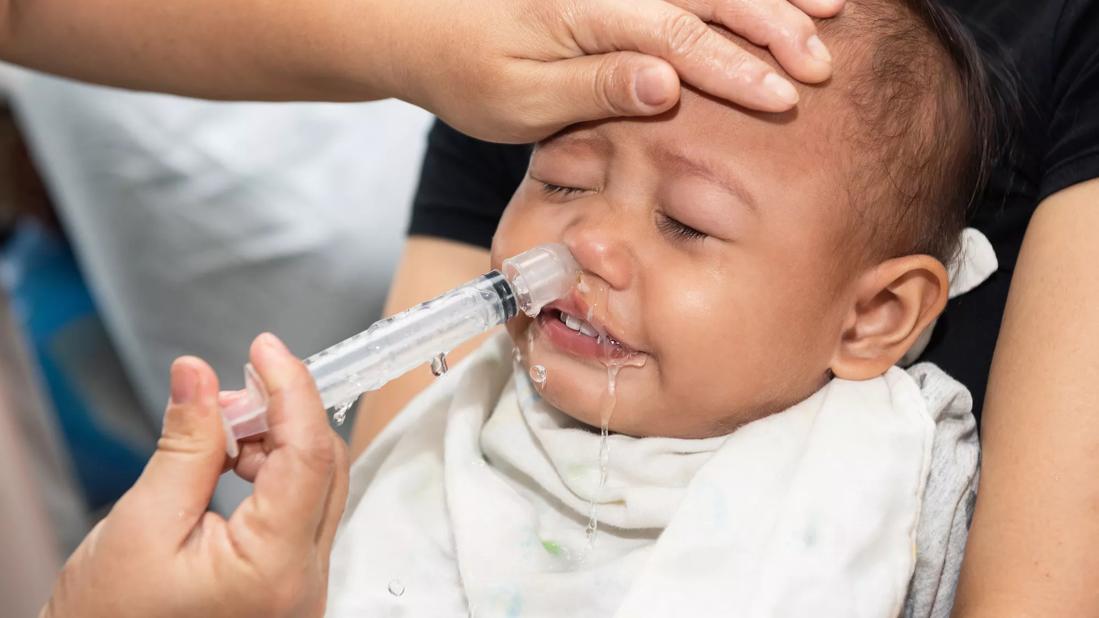Yes, it’s safe for babies starting at about 9 months old and can help clear nasal mucus

When your baby’s nose is crusty and full of mucus, it can be hard for them to breathe, eat and sleep. (Which means you’re probably not too well-rested either.) Wouldn’t it be nice to flush all that snot away?
Advertisement
Cleveland Clinic is a non-profit academic medical center. Advertising on our site helps support our mission. We do not endorse non-Cleveland Clinic products or services. Policy
Nasal irrigation is a centuries-old practice of using a salt (saline) solution to rinse the nasal passages. It’s an effective at-home treatment for allergies and upper respiratory infections — and it’s even safe for babies.
“Young children can’t blow their noses,” says pediatrician Lisa Diard, MD. “Nasal irrigation can reduce mucus and open their nasal passages. It’s also been shown to reduce the need for over-the-counter and prescription medications, including antibiotics.”
Dr. Diard explains how to flush your baby’s nose and at what age you can start.
It’s important to take special care when preparing for nasal irrigation. Young children’s immune systems are still developing, says Dr. Diard. To protect your baby’s health, make sure to carefully follow instructions for mixing the saline solution and flushing the nasal passages.
The saline solution in nasal irrigation matches the natural saltiness of your baby’s body.
“Salt water is soothing to sinus tissues, compared with plain water, which can cause irritation and dryness,” explains Dr. Diard.
To make the saline solution for nasal irrigation:
Advertisement
The sinuses are connected spaces. Nasal irrigation takes advantage of the link between the right and left nasal passages. You introduce fluid into one nostril and it drains out the other side — carrying mucus and debris with it.
There are many types of nasal irrigation devices. Make sure to get a device designed for babies. It’ll have an irrigation tip that fits into your baby’s nostril. The most common devices are:
To flush your baby’s nose:
Repeat up to three times per day.
Nasal flushes are best for children who can sit up and lean forward. For most babies, that’s at about 9 months, says Dr. Diard.
Nasal irrigation is safe for babies. The main risk is introducing harmful bacteria into your baby’s sinuses. Using clean equipment and sterile water reduces that risk.
Dr. Diard also recommends checking with your child’s healthcare provider before nasal irrigation if your child has:
If your child isn’t quite ready for nasal irrigation, Dr. Diard recommends other strategies, such as:
Many parents think young children won’t be able to tolerate nasal irrigation.
“Most children do very well,” reassures Dr. Diard. “Before trying nasal irrigation, I often suggest using saline nasal drops and a suction bulb. This can help a child get used to having fluid in their nose and make nasal irrigation easier.”
Advertisement
Learn more about our editorial process.
Advertisement

Neti pots can be useful for sinus pressure relief and removing excess mucus

Adding extra formula, cereal or medications to your baby’s bottle is a dangerous and misguided practice

Teaching your baby to sign may help ease frustrations before they can talk, but it’s not a must-do

Babies can get congested easily, but you can calm their cough by keeping them hydrated, using nasal drops and running a humidifier

Gripe water isn’t regulated by the FDA, and research doesn’t support its use

Preschool age is typically between 3 and 5 — but readiness may matter more

It’s not just about people you don’t know — it’s about behaviors that don’t feel right.

Your child may be ready if they’ve outgrown their crib or keep escaping it, or if they seem mature enough to make the switch

The best parenting style balances enforcing rules and showing plenty of love

Tips include cutting back on sugar, focusing on exercise and managing stress

It can be harder to let go when you’ve invested time, energy and emotions — but it might be the healthier choice long term